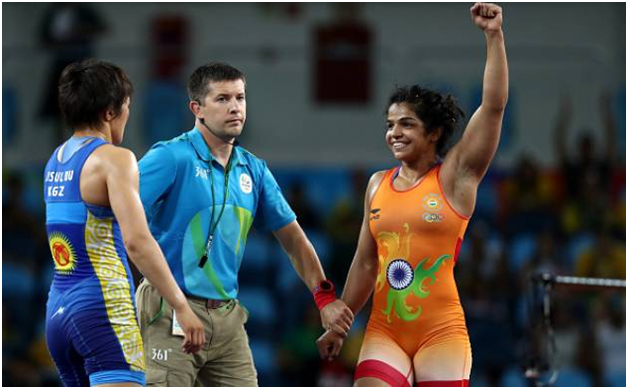Rohtak to Rio: The Curious Case of Sakshi Malik

Chhotu Ram Stadium Wrestling Academy in Rohtak is an obscure spectacle, aspiring women wrestlers take on men to toughen up. Sakshi Malik – who won India the first medal (bronze) through Repechage in the 58-kg category of Women’s Freestyle Wrestling in the ongoing Rio Olympics – is one rare product from the institution.
In the wee hours of Thursday, when author Shobhaa De – who earlier condemned the Indian contingent for not bagging medals – slept in her air-conditioned upscale apartment, the 23-year-old rode through Orkhon Purevdorj (Mongolia) and Aisuluu Tynybekova (Kyrgyzstan) in Rio.
India were on the verge of staring at further embarrassments when Sakshi’s bout made the bulbs in Mokhra (her village) flicker.
When she started off, at the age of 12, social issues in the agrarian Haryana made life thorny for grapplers – the state also has the disrepute for female foeticide. People still discriminate on the basis of caste and race, the sex ratio and literacy rate is low too.
Despite the existing taboos, it is astounding to note Haryana’s immense contribution to Indian wrestling.
Mahavir Singh Phogat brought a new wave in the mentality, made wrestling a ritual. During the epoch when pregnant women underwent abortions (society selected the sex), Phogat trained her daughters to be world-class wrestlers.
Sakshi’s triumph is not only India’s coup in an event dominated by middle-east nations, it is a step up for the people of Haryana. This is India’s fifth wrestling medal in the history of Olympics.
She also happens to be the first woman wrestler to bag an Olympic medal and the fourth female athlete to reach the podium.
“I thought of wrestling day and night and my country had lots of expectations. I had already planned to run with the flag if I bag a medal, this was a part of my visualization,” said Malik, who fought tooth and nail till her last breath.
When Saina Nehwal, Rohan Bopanna, Sania Mirza – all dashed India’s hopes in Rio, the burden fell on wrestling; the sport which endured string of controversies before the start of the mega event.
Sushil Kumar-Narsingh Yadav row continued till the latter faced a four-year ban before starting his Rio campaign. His episode trickled further down to other athletes (shot-putter Inderjeet Singh) and the world started looking at India as the new center for doping.
But all that mattered to Sakshi was a medal at any cost.
“I told myself if I fight till last, I will get a medal. There was no negative feeling, people were banking on wrestlers after a lot of athletes bowed out in the first week,” added Malik, whose coach Ishwar Singh Dahiya went against conventions to make her wrestle with boys which gradually made Rohtak the hub of wrestling.
Sakshi apparently requested to be coached like a boy.
It wasn’t easy.
During early days, the women didn’t even have the professional gear (mainly, costume); they trained wearing t-shirts. In fact, the women, in many instances, trained the boys.
The mini dynamite that exploded in Rio maintained the legacy started by Kavita and Suman Kundu (bronze winner, Commonwealth Games 2010).
Another factor for the institution’s success is the support of senior male wrestlers for the aspiring crop.
The discipline maintained by senior wrestlers escalated garnered inspiration and trust.
According to reports, the senior wrestlers – after stardom– ensured the equipments were in place.
In Sakshi’s school, no girl is hesitant to train with boys and vice-versa; the result is right in front of you.
More power to you, Sakshi.



